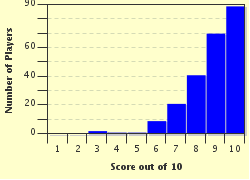Quiz Answer Key and Fun Facts
1. Situated between Asia and Europe, which of the following bodies of water is the world's largest inland sea?
2. One of North America's greatest wonders, which of the following rivers helped form the Grand Canyon?
3. Which of the following of the Great Lakes is found completely within the United States?
4. On which continent is the Okavango River Delta found?
5. Is the Great Barrier Reef located off the east coast of Australia made up mainly of coral?
6. Volcanoes are found around the world, but which of the following volcanoes destroyed the Roman city of Pompeii in 79 A.D.?
7. This satellite image is of which of the following oceans found on Earth?
8. Is the Thames Estuary part of the River Thames, located in England?
9. Uluru (or Ayers Rock) is found on which of the following continents?
10. Which of the following mountain ranges CANNOT be found in this satellite image of the western half of the United States of America?
Source: Author
mcsurfie
This quiz was reviewed by FunTrivia editor
NatalieW before going online.
Any errors found in FunTrivia content are routinely corrected through our feedback system.


